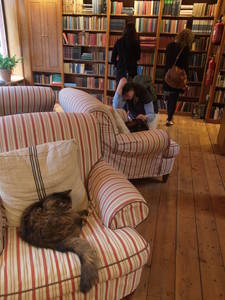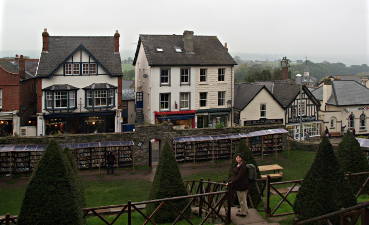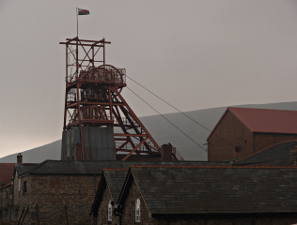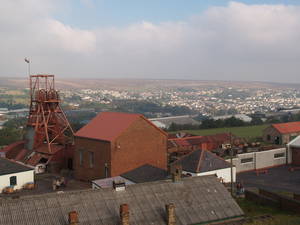We spent a weekend on the Welsh border, staying two nights in Ewyas Harold (pronounced "Yewass") in the Old Rectory B&B. This was a lovely house, very comfortably set up, with the only slightly disconcerting feature the ubiquitous hunting paraphernalia and paintings.
On the Saturday we visited Hay-on-Wye. This was a lot of fun — the guide lists 25 bookshops and we must have visited 15 of them — but I restrained myself and only bought one book (from Hay Castle Bookshop, from the King of Hay himself). And there were plenty of other shops, selling maps and prints, clothing, homewares, etc., from which Camilla bought a bit.
The weather was overcast and foggy, but the scenery was still nice. We drove to Hay up the Golden Valley, via Abbey Dore, and came back over the mountains, via Abergavenny.
On the Sunday we visited Blaenavon. The whole area here is World Heritage listed, representing the coal mines and ironworks of South Wales and Britain, which played a key role in the Industrial Revolution and were at the centre of mining communities for centuries.
We started at the visitors centre, which has a brief history of Blaenavon town and the World Heritage listing, then went to the Ironworks, which is the most intact site of its kind and also has some restored workers cottages.
The big attraction, however, is the Big Pit Coal Museum. Here we went on the fifty minute underground tour, which goes 120 metres down what was a functioning coal mine. This gives a much better feel for working underground than any description. There are a lot of buildings that can be visited, but the old baths contain a more traditional museum, with equipment, oral histories, photographs, and much more. There's also a gallery with quite realistic walk-in reconstructions of different kinds of mine faces, along with video commentary.
We didn't get to do any walking, opting for the museum because of the weather, but we came back with a packet of cards describing walks in South Wales and Brecon Beacons, and pamphlets describing the walks around Blaenavon. It did clear on the Sunday afternoon, however, and we had lovely light driving back to Oxford through the Forest of Dean.
The area definitely warrants another visit!






I often wondered what those B&B places serve up. Do you get a full hearty meal with rashers of bacon, minute steak, eggs, toasts and tea, or is it just a measly, lousy sausage or even less, just toasts and marmalade, and tea. I care because I am a serious eater. To hell with cholesterol.
Touring a working coal mine, now that is something on track and yet off the beaten track. Never been to one, but I believe some mines in Sth. Africa are up to 2 km down. It takes an hour or more just to get below.
Blaenavon, is it close to Aberfan? I ask because I remember a generation of young children was wiped out in the '60s when a coal slag heap caved-in, burying dozens of children playing near by. It was a tragedy that shocked and shook the world. Since then, the name Aberfan never left me.
http://en.wikipedia.org/wiki/Aberfan_disaster
It was a pretty posh B&B, and the breakfast options included the full English breakfast with sausage and bacon and egg, as well as a range of cereal and bread and jams. And they had decent quality ingredients, too.
Aberfan is to the west of Blaenavon, about 40 minutes by car. The disaster there featured in the Big Pit coal museum, along with other coal mine disasters. Because of the gas problems and the number of people employed, the worst mining accidents in Britain seem to have been in coal mines.
The guide on our underground tour was my age, but had spent twenty five years as a miner, starting at sixteen!
Your tour guide is eminently qualified to take your group on a conducted tour of a coal mine. I guess you'd walk away with a new perspective on what the job entails, especially in the old days or in third world countries.
Mining disasters are common occurrence in China, where the number of deaths is measured in the thousands. State-run mines have some resemblance of order and organisation. The fly-by-night operators do not even have an OH&S induction for the workers. Deaths in ones and twos do not get a mention. There are no enquiries, no coroner's reports, no due process. Life is cheap.
It pains me every time I hear of a major mining disaster in China, the country of my origin. Every death is not a mere stat., it is some household's principal income earner, someone's son, husband, father, brother, or loved one. The economic miracle has driven the peasant farmers to seek work elsewhere. Income disparity and lack of other skills forced them to accept any work, even great risk is involved.
We all now share in the joy, rapture and perhaps a little emotional for the successful rescue of all the trapped miners in Chile. Good news are in short supply.
Hi Danny
I don't know if you remember me. We played chess against each other in the late 80s & early 90s. Good to see you having a great time in Wales, have you had a leek yet?
I noticed on your homepage you have a Quiz, Name the nine languages that have over 100 million native speakers. There is now 10 as of 2008 Punjabi has 76 million native speakers in Pakistan and 29 million in India.(according to Wikipedia)I think you probably wrote that question in 2005 when it was correct.
cheers
Mal
Hi Mal, your name rings a bell, though my memory for events from my school years is terrible - I think every time I read a book I forget another person, or maybe an entire day. Are you still playing chess?
Ethnologue gives 28 million for Eastern Punjabi and 63 million for Western Punjabi (and says "There is a continuum of varieties between Eastern and Western Panjabi, and with western Hindi and Urdu"). There are also quite a number of Punjabi speakers where I am in east Oxford!
I think I'll leave it off the quiz for the moment, anyway, though ten would be a nice round number.
When it comes to safety, the Chinese mining industry seems to be where the UK was sixty or more years ago. They should be able to learn from technological improvements in the rest of the world, but it will be interesting to see whether legislative reforms will work without political changes that give individuals more influence. As it is, the central government seems to pass a lot of laws that are largely ignored by local governments and private corporations.
Hi Danny
I notice the Ethnologue figures are quite old 1991 and 2000. I can see your point with eastern and western versions. There is a bit of controversy over whether they are separate languages or not.
the following quote was taken from http://www.experiencefestival.com/punjabi_-_western_and_eastern_punjabi
"Many sources subdivide the Punjabi language into Western Punjabi — Lehnda (ਲੇਹੰਦਾ), Lahnda (ਲਹਿੰਦਾ) and Lahndi (ਲਹਿੰਦੀ) are all used synonymously — and Eastern Punjabi. They tend to do so based on GA Grierson's Linguistic Survey of India. The decision to divide the language has been controversial and most Punjabis (and many linguists) do not divide the language into two."
To answer your question on chess. After 10 years as Mingara Chess club President and six years as NSWCA Webmaster(the only type of chessmaster I will ever be),I was suffering a case of chess overload so I quit both positions. I have only played in 2 chess tourneys in the past 3 years although I still play a bit socially.
Cheers
Mal